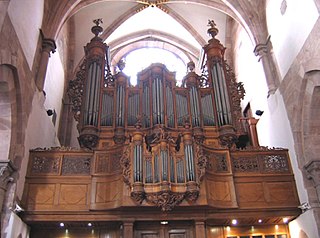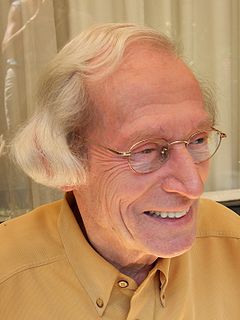
The pipe organ is a musical instrument that produces sound by driving pressurized air through the organ pipes selected from a keyboard. Because each pipe produces a single pitch, the pipes are provided in sets called ranks, each of which has a common timbre and volume throughout the keyboard compass. Most organs have many ranks of pipes of differing timbre, pitch, and volume that the player can employ singly or in combination through the use of controls called stops.

In music, the organ is a keyboard instrument of one or more pipe divisions or other means for producing tones, each played from its own manual, with the hands, or pedalboard, with the feet.

An electric organ, also known as electronic organ, is an electronic keyboard instrument which was derived from the harmonium, pipe organ and theatre organ. Originally designed to imitate their sound, or orchestral sounds, it has since developed into several types of instruments:

The American Guild of Organists (AGO) is an international organization of academic, church, and concert organists in the US, headquartered in New York City with its administrative offices in the Interchurch Center. Founded as a professional educational association, it was chartered by the Board of Regents of the University of the State of New York in 1896, with the authority to grant certificates of associate or fellow to members who passed examinations.

A theatre organ is a type of pipe organ developed to accompany silent films, from the 1900s to the 1920s.

Ernest Martin Skinner was an American pipe organ builder. His electro-pneumatic switching systems advanced the technology of organ building in the first part of the 20th century.
Mathias Peter Møller, commonly known as M.P. Möller or Moeller, was a prolific pipe-organ builder and businessman. A native of the Danish island of Bornholm, he emigrated to the United States in 1872 and founded the M.P. Moller Pipe Organ Company in Greencastle, Pennsylvania, in 1875. The city of Hagerstown, Maryland, took notice of Möller's early successes and induced him to move his business there in 1881 to help make it a viable business center in Western Maryland. The company remained in business in Hagerstown. until 1992, with hundreds of employees at its peak and a lifetime production of over 12,000 instruments.
Hendrik Niehoff was a Dutch pipe organ builder.

The organ of the St. Jacobi Church in Hamburg, was built from 1689 to 1693 by the most renowned organ builder of his time, Arp Schnitger. The organ boasts four manuals and pedal with 60 stops, 15 of which are reeds – and has approximately 4000 sounding pipes. All in all, from the organ's original installation and its condition today not much of its conception has changed. The old pipework and the prospect pipes have been preserved in almost original format. It is the largest organ in existence from before 1700 and is one of the most eminent Baroque instruments that have been preserved.

Pieter William Kee was a Dutch organist and composer.

Frederick Lewis Swann was an American church and concert organist, choral conductor, composer, and president of the American Guild of Organists. His extensive discography includes both solo organ works and choral ensembles he has conducted.
The Organ Historical Society is a not-for-profit organization primarily composed of pipe organ enthusiasts interested in the instrument's design, construction, conservation and use in musical performance. Formed in 1956, the headquarters moved from Richmond, Virginia, to Villanova, Pennsylvania, in 2017.
John T. Fesperman was an American conductor, organist and author of several books on organs. From 1965 to 1995 he worked at the Division of Musical Instruments at the National Museum of History and Technology, part of the Smithsonian Institution.

An organist is a musician who plays any type of organ. An organist may play solo organ works, play with an ensemble or orchestra, or accompany one or more singers or instrumental soloists. In addition, an organist may accompany congregational hymn-singing and play liturgical music.

Martin Ellis is an American church, concert and theatre organist. He is currently the organist for Rose City Park Presbyterian Church in Portland, Oregon. He was Principal Organist and Assistant Music Director at North United Methodist Church, and Senior Staff Pianist/Organist, Staff Arranger and Orchestrator for the Indianapolis Children's Choir and Youth Chorale in Indianapolis, Indiana until August, 2014. He works with Gresham High School's Theatre Arts Department as their resident piano accompanist.

Paul Walcker was a German pipe organ builder.
Damin Spritzer is an American organist and academic. Since 2015, Spritzer has served as assistant professor of organ at the University of Oklahoma, and continues to serve the Cathedral Church of Saint Matthew in Dallas as Artist-in-Residence for the Cathedral Arts series. She also served as adjunct professor at the University of North Texas before moving to Oklahoma. Between 2009-2014, Spritzer was associate director of Music for University Park United Methodist Church in Dallas, Texas and Saint Rita Catholic Community, in Dallas Texas, from 2000 until 2008. She has served on the board of directors for the Leupold Foundation, a charity for pipe organ music and culture, and also is active in the Southern Plains Chapter of the American Guild of Organists.
Stef Tuinstra is a Dutch organist, organ expert and author.
Bernhardt Hilbrand Edskes was a Dutch-Swiss organist, organologist, and organ builder based in Wohlen.













